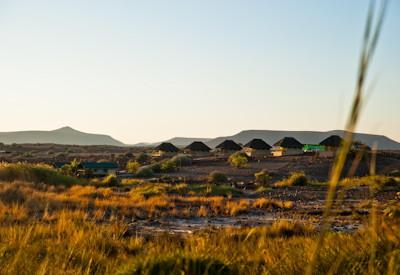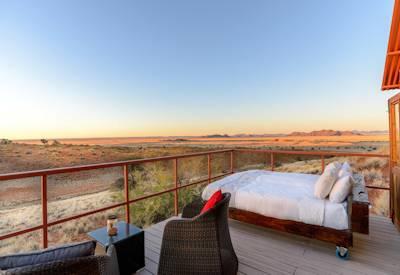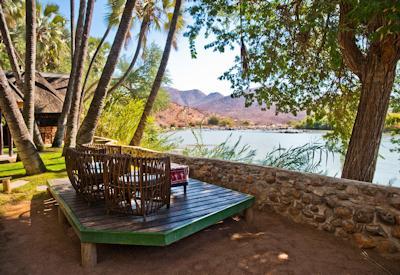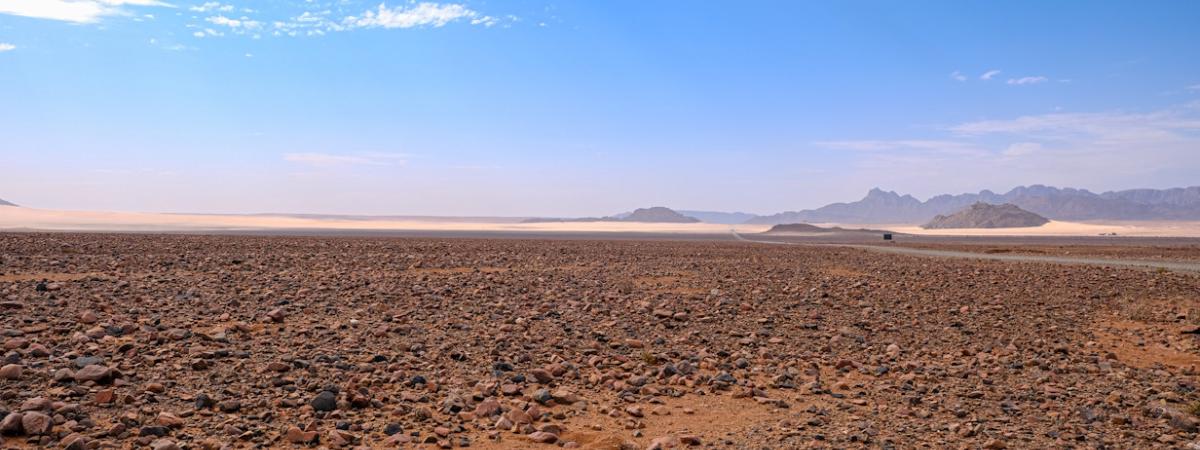
Are you ready to embark on an unforgettable Namibia safari? Namibia, a Southern African gem, offers breathtaking landscapes, fascinating wildlife encounters, rich cultural experiences, and thrilling adventure activities. In this ultimate guide, we'll take you on an exciting safari through Namibia, from the towering sand dunes of Sossusvlei to the eerie Skeleton Coast. So, fasten your seatbelts and let's explore this beautiful country together!
Key Takeaways
- Explore Namibia's unique landscapes, from Sossusvlei to the Skeleton Coast!
- Experience an unforgettable wildlife encounter in Etosha National Park and plan your road trip with essential tips.
- Enjoy cultural experiences, delicious cuisine, thrilling adventure activities and stay connected with local SIM cards!
Exploring Namibia's Unique Landscapes

Namibia boasts some of the most awe-inspiring landscapes on the planet. With its dramatic desert vistas, vast canyons, and haunting coastlines, it's no wonder that travellers from all over the world are drawn to this captivating destination. Prepare to be captivated by the mesmerising beauty of Sossusvlei, Fish River Canyon, and Skeleton Coast.
Sossusvlei
Sossusvlei, located in the southern part of Namibia, is a stunning salt and clay pan surrounded by towering red dunes. This breathtaking landscape is home to Deadvlei, a white clay pan surrounded by the highest sand dunes in the world. It's a must-visit destination for photographers and nature enthusiasts alike.
There's more to Sossusvlei than just its iconic desert scenery. The area offers a range of activities and accommodations to suit all tastes and budgets, including:
- Hot air ballooning
- Sandboarding
- Quad biking
- Luxury lodges
- Budget-friendly campsites
The best time to visit Sossusvlei is during the dry season (May to October), so be sure to plan your trip accordingly and bring appropriate camping gear if you choose to camp.
Fish River Canyon
Fish River Canyon, the second-largest canyon in the world, is another must-see destination in Namibia. Although it's not close to major towns, the journey is well worth it for its stunning views and challenging hiking trails.
Don't miss the opportunity to witness the grandeur of this natural wonder firsthand.
Skeleton Coast
The Skeleton Coast, stretching from the old German colonial town of Swakopmund to the Angolan border, is a hauntingly beautiful and remote part of Namibia's Atlantic coast. This rugged landscape, with rocky cliffs, sand dunes, and dry riverbeds, is home to a variety of wildlife, including seals, dolphins, and sea birds. It's also a popular spot for whale watching, especially near Walvis Bay. Free roaming lions can also be spotted as well as brown hyena, oryx, giraffe and springbok to mention a few.
The Skeleton Coast's history is just as intriguing as its natural beauty. The area is known for its incredible shipwrecks and the epic battle that took place during World War II. Exploring the Skeleton Coast is an eerie yet unforgettable experience that should be on every traveller's Namibian itinerary.
Essential Tips for Road Tripping in Namibia

Road-tripping in Namibia is an adventure like no other, allowing you to immerse yourself in the country's diverse landscapes and wildlife. But, to ensure a smooth and enjoyable Namibia trip, careful planning is essential. To help you prepare, we've gathered some Namibia travel tips.
This section covers important aspects like renting a suitable vehicle, mapping out your route, and stocking up on essential supplies.
Renting a Vehicle
Navigating Namibia's challenging terrain requires a reliable and sturdy vehicle. A 4-wheel drive with high clearance is highly recommended for exploring the country's impressive highlights, like Etosha National Park and Damaraland. Ensure that you have adequate insurance coverage for peace of mind during your road trip.
If you plan to stay in Namibia for more than 90 days or your driver's license is not in English, you'll need an international driver's license. Checking with the rental car agency for any additional features like Bluetooth or aux cord connectivity is beneficial.
Planning Your Route
To make the most out of your Namibian road trip, plan your route carefully. Include must-see destinations like:
- Windhoek
- Fish River Canyon
- Sossusvlei
- Swakopmund
- Etosha National Park
Allocate enough time for driving on gravel roads and stopping for wildlife sightings. And remember, the journey is just as important as the destination, so don't be afraid to take detours and explore off the beaten path.
Supplies and Preparation
Embarking on a road trip in Namibia requires stocking up on supplies and preparing for any potential situation. Bring a first aid kit, insect repellent, flashlight, GPS, a good road map, and a mobile phone. Also, pack toiletries such as sunscreen, biodegradable baby wipes, bug spray, and face and body lotion, as well as clothing and shoes suitable for the Namibian climate.
If you plan to travel through remote areas, it's crucial to bring two spare tires and extra fuel, travel in a group of at least 2-3 vehicles or book a guided tour. It's also a good idea to carry some fruit, veggies, or water to hand out to locals who may flag you down along the way. Your kindness could make a world of difference to someone in need.
Wildlife Encounters in Etosha National Park
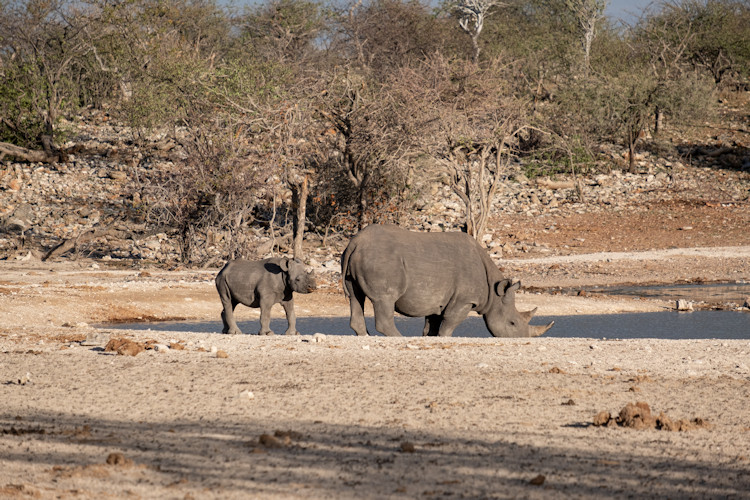
One of the highlights of any trip to Namibia is a visit to the renowned Etosha National Park, which is among the most spectacular national parks. Home to an array of wild animals, the park offers incredible opportunities for wildlife encounters.
This part will disclose the optimal times to visit and provide insights on enhancing your wildlife viewing experience.
Best Times to Visit
The best time to visit Etosha National Park is during the dry season, which runs from May to October. During these months, the weather is pleasant, and animals flock to the limited water supplies. This makes it an optimal time for wildlife viewing, as animals are more active and easier to spot.
Wildlife Viewing Tips
To maximise your chances of spotting wildlife in Etosha, follow these tips:
- Visit waterholes early in the morning or late in the afternoon
- Be patient, as animals may take time to appear
- Keep your eyes peeled for any signs of movement
With a little perseverance, you'll be rewarded with unforgettable encounters with Namibia's incredible wildlife.
Cultural Experiences in Namibia

Namibia's rich culture is an integral part of the country's allure. By meeting local tribes and exploring historical sites, you'll gain a deeper understanding of this diverse nation.
This part will explore the distinctive cultural experiences that Namibia has to offer.
Meeting Local Tribes
Namibia is home to various ethnic groups, including the fascinating Himba and San tribes. By visiting these tribes, you can learn about their traditions, beliefs, and way of life.
The best place to meet the Himba tribe is in Opuwo, in the Kunene region of northern Namibia. Support the Himba village by bringing food or purchasing handicrafts from the women.
Historical Sites
Namibia's history is just as captivating as its landscapes. Explore historical sites such as the Twyfelfontein rock engravings, a UNESCO World Heritage Site, and the colonial architecture of Swakopmund. These sites offer a glimpse into Namibia's rich history and cultural heritage, providing a fascinating backdrop for your adventures.
Practical Travel Information for Namibia
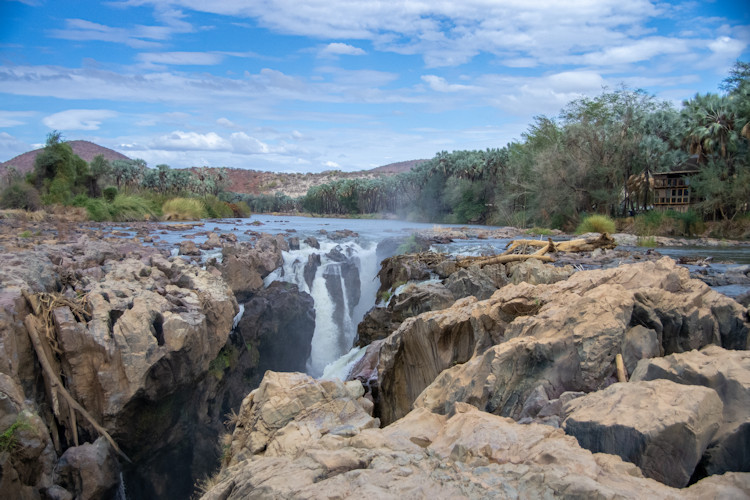
Before setting off on your Namibian adventure, getting acquainted with practical travel information is beneficial. In this section, we'll cover currency, language, and safety tips to ensure a smooth and enjoyable trip.
Currency and Money Matters
The Namibian Dollar is the official currency, but the South African Rand is also widely accepted at a 1:1 exchange rate. Although Visa and MasterCard are widely accepted, carrying some cash for tipping and situations where credit cards aren't accepted is recommended.
It is advisable to request South African Rands when withdrawing money near the end of a trip or travelling elsewhere. This is because Rands are much easier to exchange in other countries compared to Namibian dollars. Be prepared for possible ATM withdrawal limits of around N$1500-2000 per day.
Language and Communication
English is spoken by a majority of people in Namibia. It is also the country's official language. However, many locals also speak Afrikaans and indigenous languages, such as Oshiwambo and Khoekhoegowab. While travelling, you'll likely find that most people can communicate with you in English, but learning a few basic phrases in the local languages can be a great way to connect with the people you meet.
Safety and Security
Regarded as one of the safest countries in Africa for travellers, Namibia still necessitates exercising caution and common sense, just like in South Africa and other African countries. Avoid wearing expensive jewellery or watches, and always ensure your car is locked, windows are closed, and belongings are out of sight when you stop in towns or at petrol stations.
In the unlikely event that you experience a robbery, be sure to obtain a police report for insurance purposes.
Accommodation Options in Namibia
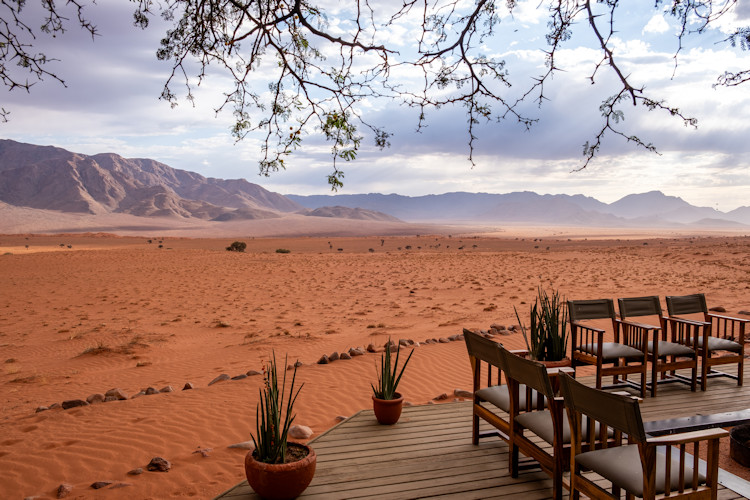
Accommodation options in Namibia cater to a wide range of preferences and budgets. From luxurious lodges to budget-friendly campsites, you're sure to find the perfect place to rest your head after a day of exploring.
Luxury Lodges
Luxury lodges in Namibia offer a comfortable stay with amazing amenities such as swimming pools, Wi-Fi, and on-site dining. Some of the best luxury lodges include Onguma The Fort, Zannier Hotels Omaanda, Shipwreck Lodge, Wolwedans Dunes Lodge, and Hoanib Skeleton Coast. These lodges provide an indulgent retreat after a day of adventure.
Budget-Friendly Campsites
For travellers on a budget, campsites provide a more affordable accommodation option. Most campsites in Namibia offer well-maintained facilities and amenities such as:
- Electricity
- Picnic tables
- Freshwater faucets
- Wi-Fi (some campsites)
- Swimming pools (some campsites)
Camping can be a great way to immerse yourself in Namibia's stunning landscapes and enjoy a truly authentic experience.
Best Time to Visit Namibia
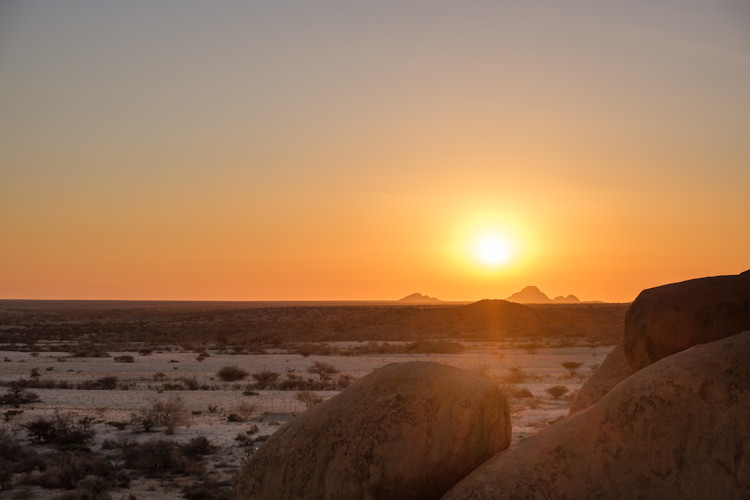
As mentioned earlier, the best time to visit Namibia is during the dry season (winter) which runs from May to October. This period offers optimal wildlife viewing opportunities and pleasant temperatures. By planning your trip during this timeframe, you'll maximise your chances of experiencing all that Namibia has to offer.
Adventure Activities in Namibia
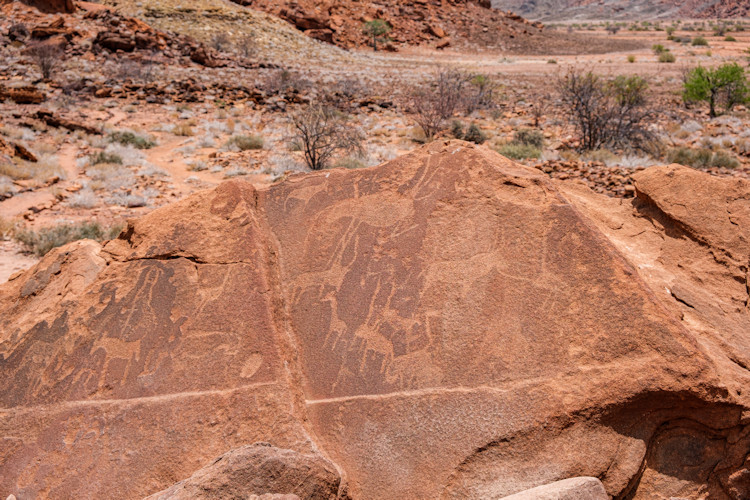
Namibia is a dream destination for thrill-seekers and adventure enthusiasts. The diverse landscape provides the perfect playground for activities like hot-air ballooning, sandboarding, and quad-biking.
Let's explore these exciting adventures that await you when you travel to Namibia.
Hot Air Ballooning
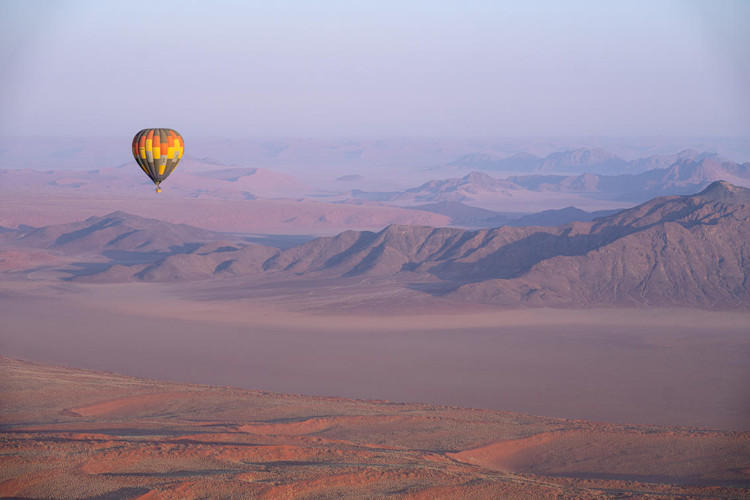
Imagine floating high above the Namibian desert, taking in the breathtaking views of the dunes, mountains, and wildlife below. Hot air ballooning is an unforgettable experience that offers a bird's-eye view of Namibia's stunning landscapes. The best time to enjoy this once-in-a-lifetime adventure is during the dry season (May to October).
Sandboarding
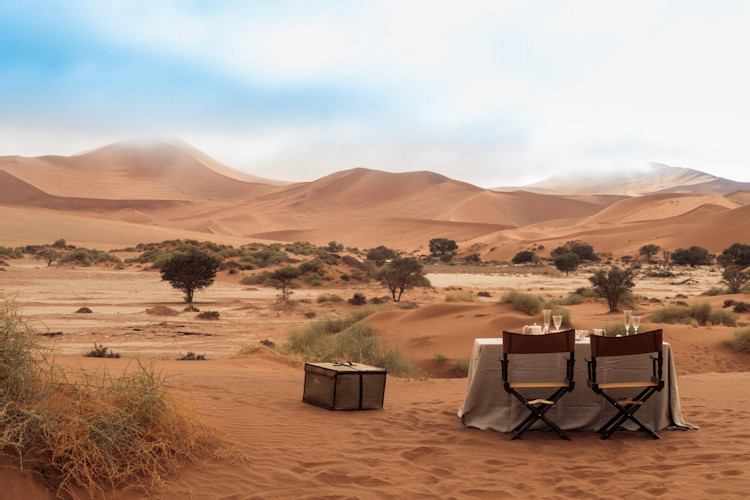
For an adrenaline-pumping adventure, try sandboarding on the dunes of Swakopmund. Similar to snowboarding, sandboarding involves riding a board down the steep slopes of sand dunes. It's a thrilling activity that's sure to get your heart racing and create lasting memories of your trip to Namibia.
Quad Biking

Another exciting way to explore Namibia's off-road terrain is by quad biking. This exhilarating activity allows you to traverse the wilderness on a four-wheeled motorbike, navigating rough terrain and discovering hidden gems along the way. Whether you're an experienced rider or a beginner, quad biking offers a unique perspective of Namibia's awe-inspiring landscapes.
Namibian Cuisine: What to Expect and Must-Try Dishes
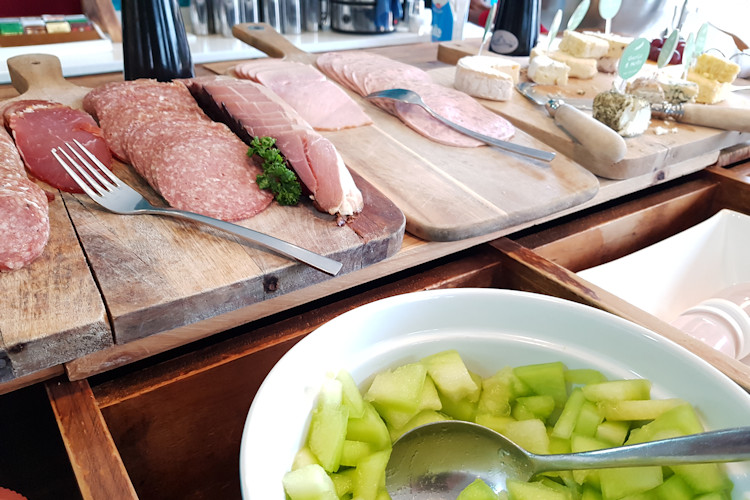
Namibian cuisine is a delicious blend of European (mainly German) and African influences, offering a unique culinary experience for food lovers. Game meats, such as warthog, kudu, impala, oryx, and zebra, are a local speciality.
Vegetarian options may be limited, but with a little creativity, you can still enjoy a variety of tasty dishes during your stay.
Packing Essentials for Namibia Travel
Preparing for your Namibian adventure involves packing the appropriate items. Here are some essentials to consider:
- Warm clothing for chilly nights and mornings
- Sturdy footwear for outdoor activities
- Sun protection, such as sunglasses, sunscreen, and a hat
- Power adapter for charging your devices
By packing wisely for your upcoming trip, you'll make sure to be well-prepared for a great trip and an unforgettable experience.
Connectivity and Staying Connected in Namibia
Even though Namibia's natural beauty is a significant attraction, keep in mind that connectivity can be limited. Internet access may be slow and unreliable, and mobile network coverage can be patchy. To stay connected during your trip, consider purchasing a local SIM card or renting a satellite phone for use in remote areas. It's always better to be prepared and stay connected with loved ones back home.
Summary
As you can see, Namibia is a truly captivating destination that offers a wealth of experiences for travellers. From its awe-inspiring landscapes and incredible wildlife encounters to its rich cultural heritage and thrilling adventure activities, there's something for everyone in this beautiful country.
So, what are you waiting for? Start planning your unforgettable Namibian adventure today!
Frequently Asked Questions
It's generally safe to travel to Namibia, but it's wise to stay aware of your surroundings and enrol in the Smart Traveler Enrollment Program (STEP) to receive Alerts. Be sure to follow the Department of State on Facebook and Twitter, and review the Country Security Report for Namibia before travelling.
Yes, US citizens can visit Namibia! They must have a passport valid for at least six months beyond their return date and with at least six blank pages in order to enter the country.
A tourist visa will be issued on arrival for tourist stays up to 90 days (this may change in the future).
Namibia is a large and sparsely populated country on Africa's southwest coast, located between Angola and South Africa and bordered by the South Atlantic Ocean. It has two deserts, the Namib Desert in the west and the Kalahari Desert in the east, separated by the Central Plateau. Its colonial history dates back to the late 1800s when it was under German rule until gaining independence in 1990.
Visit Namibia during its dry season for the best possible experience - May through October!
For a smooth and exciting road trip in Namibia, rent a 4-wheel drive vehicle with high clearance - it's the best choice!
Mokuti Etosha
Nestled on the edge of the breathtaking Etosha National Park, Mokuti Etosha offers an unrivalled retreat where nature and luxury intertwine. Surrounded by pristine landscapes and abundant wildlife, this exclusive lodge provides an ideal sanctuary for travellers seeking both adventure and tranquillity.
The lodge boasts exceptional amenities designed to enhance your stay. From elegantly appointed rooms to world-class dining, every detail has been carefully curated to ensure a memorable experience.
Palmwag Lodge
Palmwag Lodge, without a doubt, stands as one of Namibia’s most iconic and sought-after tourist destinations. Nestled among rustling palm trees and surrounded by breathtaking scenery, this lodge offers an idyllic escape in the heart of the vast 450,000-hectare Palmwag Concession.
The wildlife in and around this private Damaraland concession and Palmwag Lodge is nothing short of extraordinary. From towering desert-adapted elephants to elusive predators and a wide variety of plains game, the experience is one of rich biodiversity.
Namib Dune Star Camp
Namib Dune Star Camp is a hidden gem on the iconic red dunes of the Namib Desert. With stunning views of endless plains and distant mountains, this camp brings you closer to nature. Spend a night under the stars in one of the world’s most remarkable dark sky reserves.
The camp’s star dune suites offer a unique blend of luxury and desert beauty. Each suite is designed for guests to sleep under open skies, creating magical moments in the wilderness. What’s more enchanting than stargazing in complete comfort?
Atlantic Villa Guesthouse
Atlantic Villa Guesthouse, located in the peaceful Vogelstrand area of Swakopmund, offers a coastal retreat just 6 km from the town centre. With stunning views of the Atlantic Ocean, it's a tranquil and luxurious escape.
With its enviable location just a short stroll from the ocean's edge, Atlantic Villa combines convenience with the unparalleled beauty of Swakopmund's coastline, making it the perfect haven for those seeking relaxation and elegance by the sea.
Kazile Island Lodge
Nestled in the heart of the Zambezi region, Kazile Island Lodge offers an unparalleled escape into nature's tranquillity. Surrounded by the rich biodiversity of Bwabwata National Park, the lodge provides a front-row seat to the breathtaking beauty of Namibia's wilderness.
With luxury tents overlooking the Kwando River, guests enjoy stunning views of the water and its abundant wildlife. From the distant sounds of hippos to elephants crossing nearby, every moment at Kazile Island Lodge connects you to the wild African landscape.
Swakopmund Guesthouse
The family-operated guesthouse merges environmental sustainability with luxurious amenities to welcome travellers who have explored Namibia's beautiful landscapes. Guests experience the comfort of home at Swakopmund Guesthouse because of its elegant decorations and welcoming environment.
Guests can discover the remarkable attractions of the Swakopmund area by staying at this guesthouse, which provides convenient access to the Skeleton Coast along with the Namib Desert and exciting activities like sandboarding and quad biking.
Omarunga Lodge
Epupa Falls is, without a doubt, one of the most breathtaking highlights of northern Damaraland in Namibia. Nestled along the tranquil banks of the Kunene River lies the enchanting Omarunga Lodge, a serene retreat offering an unparalleled connection to nature.
What makes this location even more extraordinary is its proximity to the stunning Epupa Falls. Just a leisurely 2-minute stroll from the lodge, you’ll find yourself standing above the cascading waters, mesmerised by their beauty.
Damara Mopane Lodge
Damara Mopane Lodge is an excellent choice for travellers exploring the breathtaking landscapes of Damaraland, offering easy access to some of the region's most iconic attractions. This charming lodge is a true gem for those embarking on a self-driving adventure.
Designed for families, Damara Mopane Lodge offers a welcoming and relaxing atmosphere, making it ideal for group travellers. Combining comfort, convenience, and proximity to famous sights, it promises an unforgettable stay in one of Namibia's most captivating regions.


